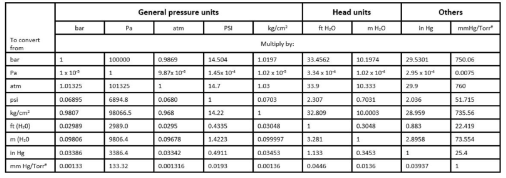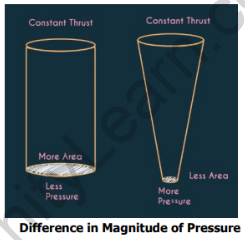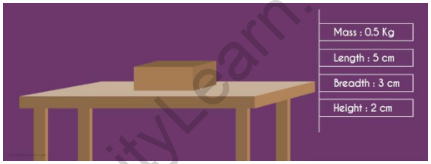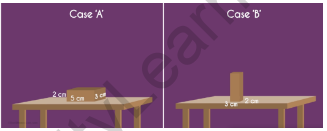Table of Contents
Pressure is a fundamental concept in physics, defined as the physical force exerted on an object. This force is applied perpendicular to the surface of the object and is measured per unit area. In mathematical terms, pressure (P) is calculated as the force (F) divided by the area (A), giving us the formula P = F/A. The standard unit of pressure is the Pascal (Pa).
What is Pressure? – Formula
Pressure is a fundamental physical concept that describes the force applied to a surface per unit area. It can be defined as the amount of force exerted on a given surface area, or simply as the ratio of force to the area over which that force is acting.
Pressure (P) = Thrust / Area
In SI units, 1 pascal (Pa) is equivalent to 1 newton per square meter (N/m²).
Let’s explore a practical example to better understand the concept of pressure. Imagine you have two pins, one sharp and one blunt, and you want to hammer them into a wooden surface. You might notice that it’s easier to hammer the sharp pin than the blunt one. Why is this the case?
The key lies in the area of contact between the pin and the surface. When you use the sharp pin, the point of contact is extremely small, which means the area (A) in the pressure formula is minimal. On the other hand, when you use the blunt pin, the point of contact is much larger, resulting in a larger area (A).
Types of Pressure
There are following types of Pressure:
- Absolute Pressure: This is the pressure measured relative to a perfect vacuum. It includes atmospheric pressure, making it the total pressure in a system.
- Atmospheric Pressure: Atmospheric pressure is the pressure exerted by the weight of the air above a specific point on Earth’s surface. At sea level, it is approximately 101.3 kPa (kilopascals).
- Differential Pressure: This type of pressure is the difference in pressure between two points in a fluid or gas system. It is often used to measure flow rates and fluid levels.
- Gauge Pressure: Gauge pressure is the pressure relative to atmospheric pressure. When a pressure gauge reads zero, it is measuring gauge pressure, meaning it accounts for atmospheric pressure.
Pressure Conversion Table

Magnitude of Pressure
The magnitude of pressure depends on the force applied and the area over which it is distributed. Pressure is inversely proportional to the area on which the thrust is applied. It means that if the thrust is constant and the area is more, the pressure will be lesser. And if the area is less, the pressure will be more.

Pressure in Fluids
In fluids (liquids and gases), pressure is transmitted equally in all directions. This is known as Pascal’s principle. In a fluid at rest, pressure increases with depth due to the weight of the fluid above it. This is expressed by the equation:
Pressure = Density × Gravity × Height
Where Density is the density of the fluid, Gravity is the acceleration due to gravity, and Height is the vertical distance from the surface.
Understanding pressure is crucial for many scientific and practical applications. It allows us to comprehend the behaviour of fluids, design effective systems, and evaluate the impact of pressure on structures and human health. Whether it’s exploring the depths of the ocean, predicting the weather, or maintaining our well-being, pressure is a concept that influences our understanding of the physical world around us.
Solved examples
Example 1: A force of 500 Newton is applied to a circular surface with a diameter of 0.2 meters. Calculate the pressure exerted on the surface.
Solution: Given
Force = 500 N
Diameter = 0.2 m
Step 1: Calculate the area of the circular surface.
Area = π × (radius)2
Radius = Diameter / 2 = 0.2 m / 2 = 0.1 m
Area = π × (0.1 m)2 = 0.0314 m²
Step 2: Calculate the pressure.
Pressure = Force / Area
Pressure = 500 N / 0.0314 m² ≈ 15,923.57 Pa
Therefore, the pressure exerted on the surface is approximately 15,923.57 Pascal (Pa).
Example 2: A block of wood is kept on a table. The mass of the wooden block is 500 grams and its dimensions are 5 cm × 3cm × 2 cm. Let us find the thrust and pressure exerted by it on the table if it is made to lie on it with its sides of dimensions (A) 5 cm × 3 cm and (B) 3 cm × 2 cm.

Solutions:
Let us find the thrust and pressure exerted by the block on the table in each of the cases.

Thrust calculation
The weight of the wooden block applies a thrust on the table. Since the weight of the box is the same in both the cases the value of thrust will also be the same. The thrust can be calculated as follows,
𝑇ℎ𝑟𝑢𝑠𝑡 = 𝐹 = 𝑚 × 𝑔
Where, ‘m’ is the mass of the block and ‘g’ is the acceleration due to gravity. The mass ‘m’ is 500 grams, which is equivalent to 0.5 kilograms and ‘g’ is 9.8 m/s2.
Thrust = F = m x g
= 0.5kg x 9.8m/s2
= 4.9 Newtons
Pressure calculation:
We can calculate the pressure in both the cars using the pressure formula,
Pressure = Thrust/Area
In case A, the area of the box in contact with the table is,
Area = 5cm x 3cm
= 15cm2 or 0.0015m2
Pressure = 4.9N/0.0015M2
= 3266.66 N.m2
We can also calculate the pressure in case B as follows:
Thrust = F = 0.5 x 9.8m/s2
= 4.9N
Area = 3cm x 2cm
= 6cm2
= 0.0006 m2
Pressure = 4.9N/0.0006m2
= 8166.66 N/m2
Hence, the pressure in case B is much more than that in case A. This is because the area of contact is lesser in case B.
FAQs On Pressure
What is pressure and its formula?
Pressure is the force applied on an object divided by the area over which it is applied. The formula for pressure is: Pressure (P) = Force (F) / Area (A).
What is pressure and its SI unit?
Pressure is the measure of how strongly a force is distributed over a given area. Its SI (International System of Units) unit is called the Pascal (Pa). So, pressure is measured in Pascals.
What is pressure in a fluid?
Pressure in a fluid refers to the force that the liquid or gas exerts on the walls of its container or any object submerged in it. It happens because the particles in the fluid are constantly moving and bumping into things, creating a push or pressure in all directions.








